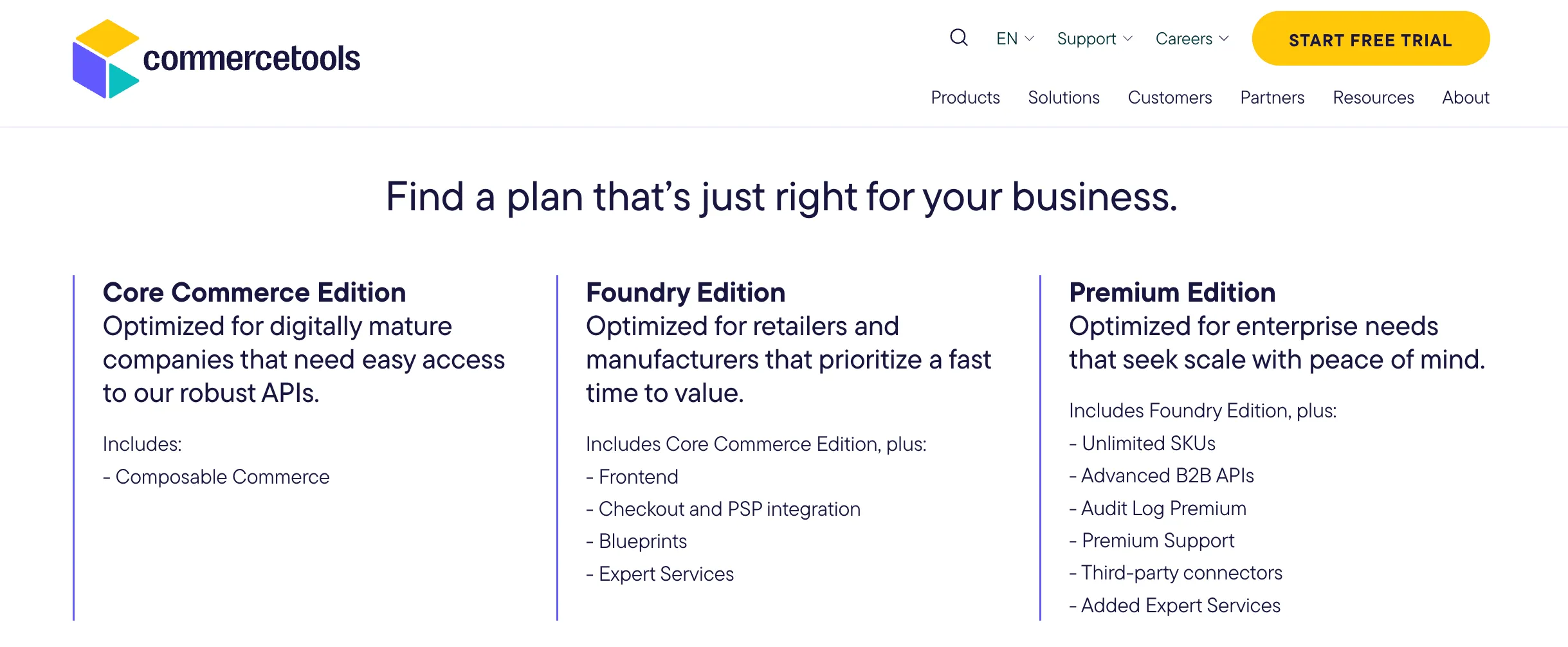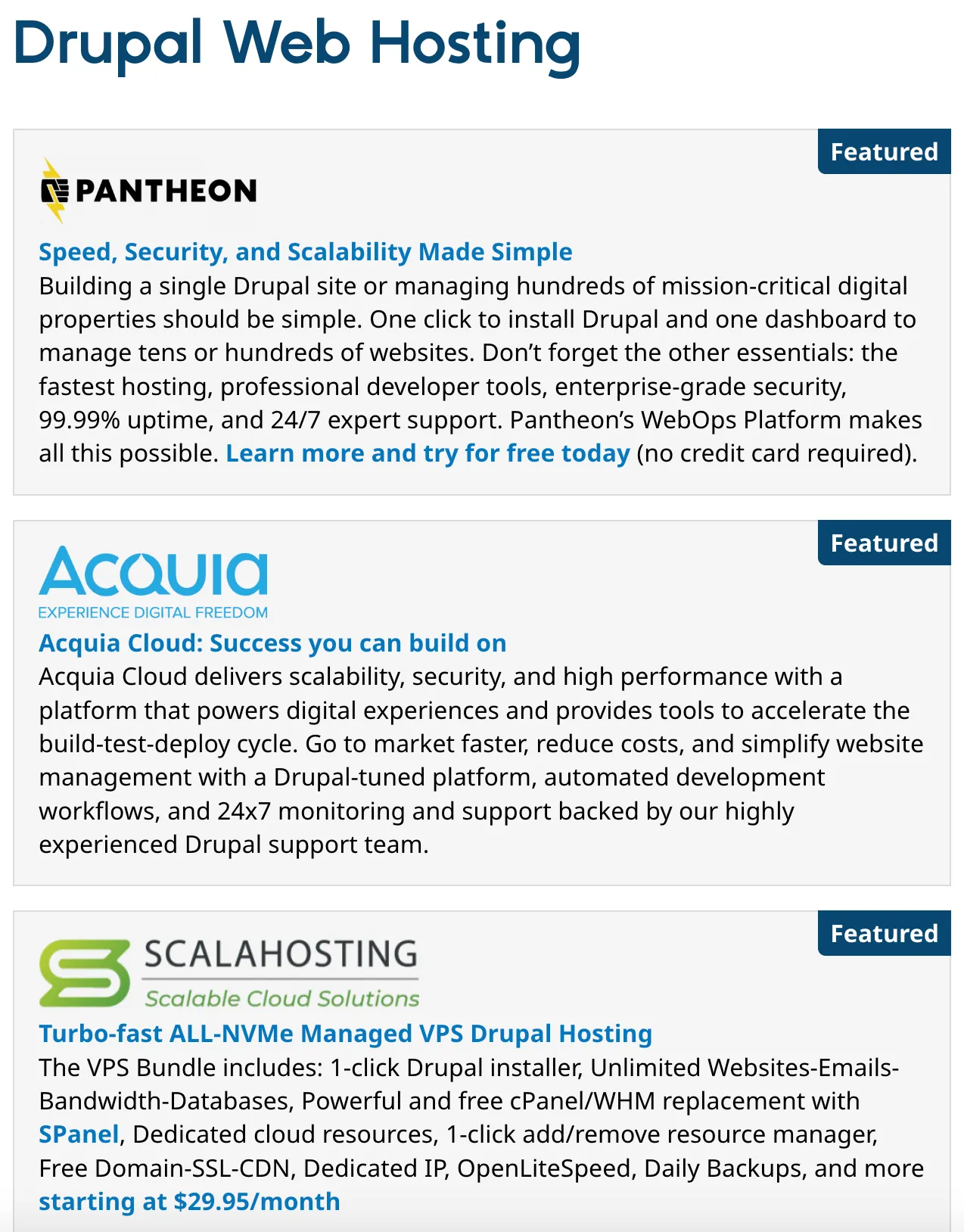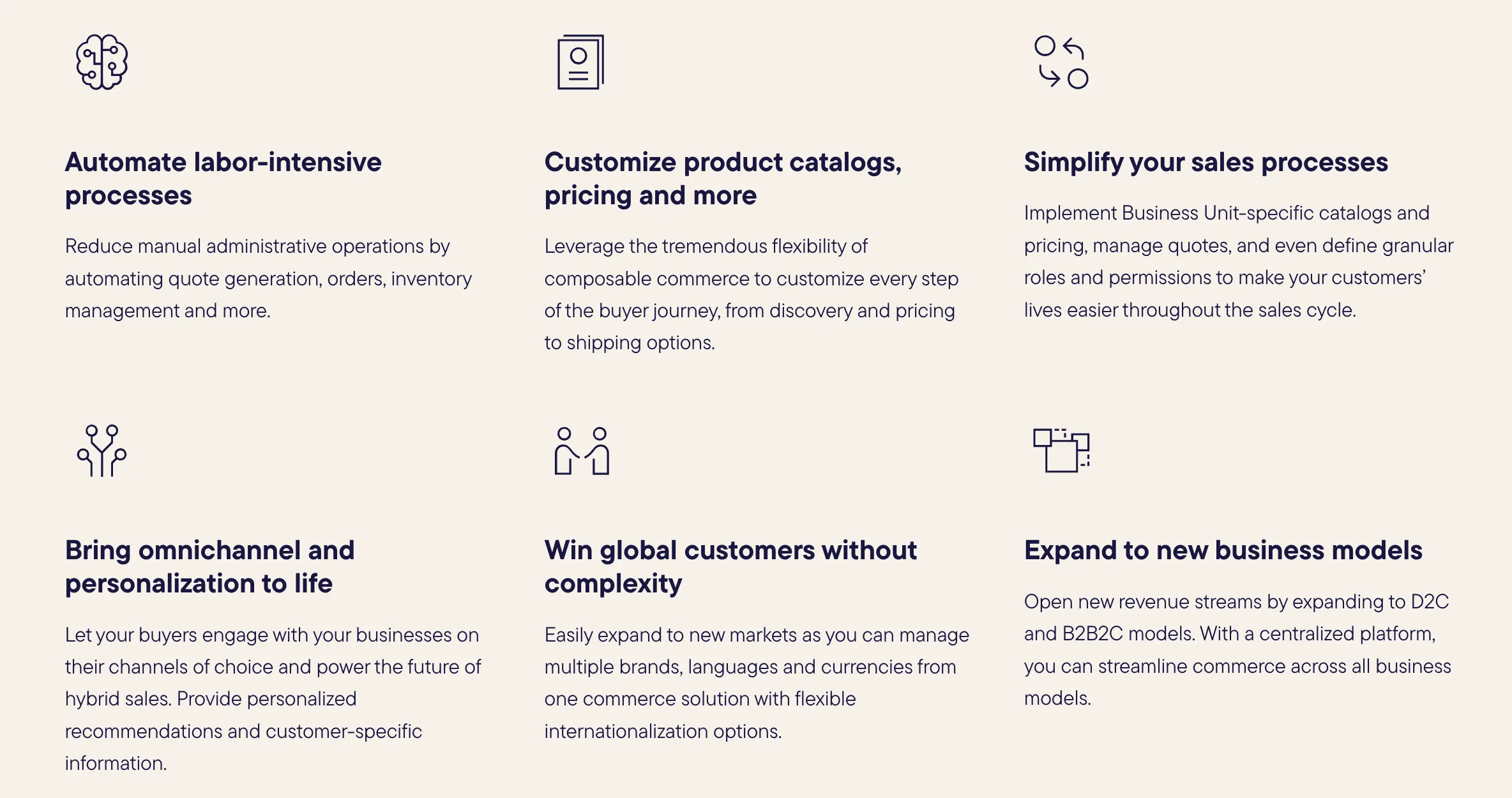If your business is deciding between commercetools vs Drupal Commerce, chances are you’re not just looking for another feature list—you’re choosing between two fundamentally different approaches to building an eCommerce experience.
On one side, commercetools is a commerce-first, API-driven platform designed for composable architectures, giving you the freedom to integrate best-of-breed services across frontend and backend. On the other side, Drupal Commerce is built into the Drupal CMS, offering a content-first experience where commerce is deeply integrated with editorial workflows, taxonomy, and multilingual content delivery.
These differences matter, especially for teams weighing questions like:
- Should our commerce stack be built around content or composed around services?
- Do we prioritize frontend flexibility or content control?
- Do we need full ownership of our platform or ready-made scalability?
In this guide, we’ll break down how commercetools and Drupal Commerce compare across architecture, customization, performance, and business fit—so you can choose the right tool for your eCommerce evolution. And if migration is part of your journey, LitExtension is here to help you get there, seamlessly.
commercetools and Drupal Commerce: Platform Overviews
Before we compare features in detail, it’s important to understand the core structure and philosophy of each platform. commercetools and Drupal Commerce are often evaluated in the same decision-making process, but they serve different architectural visions.
This section outlines how each platform works, what it’s built for, and how it aligns with modern commerce expectations, including composability, headless delivery, and long-term scalability.
commercetools overview
commercetools is a modern, cloud-native commerce platform designed with the MACH principles in mind—Microservices, API-first, Cloud-native, Headless. It decouples the frontend from the backend entirely, enabling businesses to create highly customized experiences across any channel or device.

Unlike traditional platforms, commercetools does not include a built-in CMS or templating system. Instead, it integrates with best-of-breed tools for content, payments, PIM, search, and more. This flexibility makes it a strong fit for large enterprises with complex infrastructure, multi-region operations, and a preference for composable architecture.
Key characteristics:
- Fully API-driven, headless by default
- Supports multi-store, multi-language, multi-currency out of the box
- Scales elastically in cloud environments
- Easily integrates with CMSs, CDPs, ERPs, search engines, and personalization tools
- Requires experienced developers and architectural planning
Drupal Commerce overview
Drupal Commerce is a powerful open-source eCommerce framework built as a module within the Drupal CMS. It allows businesses to manage products, carts, orders, payments, and content from a single platform—making it ideal for content-rich commerce experiences.
This tight coupling between commerce and content appeals to organizations such as nonprofits, universities, publishers, and B2B companies with structured content requirements, complex editorial workflows, and multilingual needs. While it can be made headless, Drupal Commerce is designed as a coupled system by default.

Key characteristics:
- Seamless integration of content and commerce
- Highly flexible through Drupal’s module and field system
- Fully open-source, customizable, and self-hosted
- Native support for multilingual content and editorial workflows
- Can be decoupled using GraphQL or JSON:API (requires custom setup)
While commercetools and Drupal Commerce are both powerful, they aren’t directly interchangeable. They reflect different philosophies:
- commercetools is a commerce engine that lets you build your stack from scratch with the services you choose.
- Drupal Commerce is a monolithic platform where content and commerce are deeply integrated, built on Drupal’s content modeling and layout systems.
As such, this comparison is less about matching features and more about choosing a direction: composable, API-first architecture vs integrated CMS-led commerce.
That said, many organizations today are exploring hybrid models—for example, using Drupal as a headless CMS while leveraging commercetools for backend commerce logic. This comparison will help you assess which path (or combination) best fits your team, resources, and future goals.
commercetools vs Drupal Commerce: Key Differences Comparison
While both platforms aim to power modern digital commerce, they take very different approaches. Below, we break down their key differences to help you determine which one better aligns with your needs, based on architecture, use cases, technical flexibility, and more.
A comparison table follows the detailed breakdown for quick reference.
Category | commercetools | Drupal Commerce | Winner |
Philosophy & architecture | Built on MACH (Microservices, API-first, Cloud-native, Headless); composable and decoupled by design | Monolithic by default, but decouplable via GraphQL/JSON:API; tightly integrated with Drupal CMS | commercetools |
Target audience & use case | Mid-to-large enterprises, complex B2B workflows, high-volume omnichannel setups | SMBs, nonprofits, gov/education; content-led commerce, editorial control | Tie |
Cost & hosting | Subscription-based SaaS; costs scale with GMV, API usage; managed infra | Open-source; lower upfront cost but more internal DevOps and infra responsibility | Tie |
Customization & development | Fully API-driven and frontend-agnostic; high flexibility but requires architecture planning and dev effort | Customization via Drupal's module + entity system; powerful, but Drupal-specific expertise needed | Tie |
eCommerce features | Enterprise-grade commerce out-of-the-box; B2B support (quotes, budgets, lists, multi-store) | Standard commerce features; advanced needs require contributed modules or custom development | commercetools |
Content management & CMS integration | Requires external CMS (e.g., Contentful, Sanity); no built-in content modeling | Native CMS + commerce integration; structured content, multilingual, editorial workflows | Drupal Commerce |
Security & support | Enterprise SLAs, managed cloud infra, ecosystem support via Connect & partners | Community-based; strong security track record, but implementation-dependent | commercetools |
1. Platform architecture and approach
In 2025, the architectural divide between commercetools and Drupal Commerce remains as relevant as ever. While both have matured, they continue to represent two distinct schools of thought: one rooted in composable commerce, the other in content-first integration.
commercetools is modular by design. Its architecture follows MACH principles—Microservices, API-first, Cloud-native, and Headless—allowing every commerce function to operate as a standalone service. This separation empowers businesses to scale, swap, and evolve their stack over time.

A prime example of this is commercetools’ application in B2B industries, such as the pharmaceutical industry. Using commercetools, teams can build highly specific dashboards that display purchase lists, budget tracking, reorder histories, and quotes—entirely decoupled from the backend. This kind of frontend freedom, paired with backend orchestration, is what makes commercetools a strong choice for complex, enterprise-grade commerce experiences.
Drupal Commerce, by contrast, is tightly woven into the Drupal CMS. While headless delivery via JSON:API and GraphQL has matured, composability isn’t native—it still requires deliberate planning to decouple content and commerce layers. That said, this integration is also its core advantage. Drupal Commerce excels in environments where content and commerce are deeply intertwined, offering structured content modeling, multilingual capabilities, and robust editorial workflows.

With the Drupal 11 release and the Starshot initiative driving a more streamlined experience, the ecosystem is becoming increasingly accessible and performance-focused. These developments make Drupal Commerce increasingly viable for organizations that want to unify storytelling and commerce under a single, future-ready architecture—especially in regulated, multilingual, or B2B contexts.
Winner: commercetools – It’s built for composability from the ground up, with architecture better suited for long-term flexibility.
2. Target audience & use case
The decision between commercetools and Drupal Commerce often hinges less on features, and more on fit. Each platform serves a different type of organization—not just in terms of scale, but in how commerce and content are prioritized.
Here’s a breakdown based on key business indicators:
| Criteria | commercetools | Drupal Commerce |
| Company size | Mid-to-large enterprise | SMB to mid-sized orgs, nonprofits, government, B2B |
| Annual GMV (gross merchandise value) | $5M–$3B+ | <$5M (typical), but extendable with dev support |
| Product catalog size | 10,000+ SKUs, multi-category complexity | 10–5,000 SKUs, structured via content entities |
| Traffic volume | 1M+ sessions/month, multi-region, multi-channel | Moderate to high traffic, often regional or localized |
| Business type fit | Large retailers, D2C brands, marketplaces, global B2B | Content-led commerce, B2B portals, education, government |
| Use case | Highly customized frontend/backend, omnichannel orchestration | Content-centric commerce, editorial + product integration |
commercetools is designed for mid-to-large enterprises, especially those handling high transaction volumes, operating across multiple markets, or pursuing a headless, omnichannel strategy. For example, a lifestyle D2C brand scaling from 3 to 15 international storefronts—each with localized product feeds, personalized pricing, and headless CMS control- is a strong fit for commercetools.
This platform assumes your team can invest in technical resources and architecture planning. It rewards businesses aiming to future-proof through composable commerce, omnichannel orchestration, and frontend/backend decoupling.
Meanwhile, Drupal Commerce is best suited for content-driven organizations, such as nonprofits, universities, B2B manufacturers, or government agencies, where commerce supports, rather than drives, the experience. For example, a university press that sells digital and print publications across multiple departments, featuring multilingual content and custom purchase logic, fits perfectly within Drupal Commerce.
Drupal Commerce also suits nonprofits, government portals, higher education institutions, and B2B distributors where content delivery, compliance, and structured workflows are top priorities.
Winner: Tie – Each platform serves distinct, valid use cases. Choose based on size, content dependency, and digital maturity.
3. Cost & hosting
commercetools operates on a subscription-based pricing model, typically calculated based on usage metrics such as:
- Gross Merchandise Value (GMV)
- Number of API calls
- Optional add-ons (e.g., environments, data storage, custom SLAs)
While commercetools has introduced tiered editions—like Core, Foundry, and Premium—pricing still scales with business volume.

For example, a retailer processing around $20 million per year in GMV may expect costs ranging from $50,000 to $200,000 annually, depending on the support level and usage terms. The upside: this model eliminates infrastructure management and includes full SaaS hosting, performance optimization, and auto-scaling as part of the package. The trade-off is predictability. Since pricing increases with scale, commercetools may not suit brands looking for fixed-cost operations, especially if growth is rapid or seasonal.
Drupal Commerce is free to use—no license fees, no usage tiers. But that doesn’t mean it’s zero-cost. You’ll need to budget for:
- Hosting (self-managed or via providers like Acquia or Pantheon)
- Development time for setup, customization, and module management
- DevOps and performance tuning for caching, CDN, and scalability
- Security updates and patching are often managed manually or via CI/CD pipelines

Let’s say an organization using Drupal Commerce may pay $2,000–$10,000 per year for hosting and DevOps, and $30–$150 per hour for ongoing development or support. The upside is long-term flexibility and no vendor lock-in; however, it requires strong in-house or agency resources.
Winner: Tie – commercetools offers convenience and support at a price; Drupal Commerce offers flexibility but shifts cost to internal teams.
4. Customization & development
Both commercetools and Drupal Commerce offer strong customization potential, but the depth, approach, and developer requirements differ greatly depending on your architecture, stack, and internal capabilities.
commercetools is designed for flexibility at scale. Every commerce capability is modular and exposed via APIs, giving developers full control over the frontend, backend logic, and third-party integrations. You can build with React, Next.js, or any framework of your choice, and orchestrate services like PIMs, CDPs, and AI tools independently.

This approach allows for maximum freedom, but it assumes strong architectural planning and an experienced dev team to manage the complexity.
Drupal Commerce, by contrast, is deeply integrated with the Drupal CMS and its entity system, offering powerful customization through structured content types, fields, Views, and contributed modules. It's particularly effective when commerce is tightly connected to content workflows—think editorial teams, multilingual product storytelling, or government-level publishing structures.

And with the release of Drupal 11, customization is becoming more developer-friendly and modern. Improvements to theme development, API support, and project scaffolding make it easier to extend Drupal Commerce in headless or hybrid environments, especially for teams already familiar with Drupal’s architecture.
Customization here is still Drupal-specific, but increasingly streamlined thanks to ecosystem efforts like Starshot and the growing decoupled Drupal community.
Winner: Tie – commercetools leads in composable flexibility; Drupal Commerce wins in CMS-centric extensibility.
5. eCommerce feature comparison
When it comes to core commerce functionality, both commercetools and Drupal Commerce offer robust solutions—but in very different ways. commercetools is designed to serve high-scale, API-driven operations with complex business rules, while Drupal Commerce delivers flexible commerce capabilities tightly integrated within a CMS.
To help you evaluate which platform better supports your operational needs, we’ve broken down key eCommerce features—such as product catalog management, promotions, checkout flow, order handling, and multi-store functionality—based on performance, ease of customization, and scalability.
Let’s see how they compare, feature by feature:
| Feature | commercetools | Drupal Commerce |
| Product catalog | Dynamic, API-defined | Structured through content entities |
| Promotions & discounts | Flexible API logic, rule-based | Extendable via modules |
| Checkout & cart | Fully customizable via APIs | Prebuilt, customizable through modules |
| Multi-language / currency | Native support for both | Requires modules and configuration |
| Order management | Robust, built for scale | Functional, but basic out-of-the-box |
| Shipping & tax | Plugin-based, integrates with external services | Module-based, flexible but manual |
| Multistore capabilities | Strong multi-store logic with region control | Achievable, but more dev work needed |
Put simply, commercetools leads in commerce-first functionality, while Drupal Commerce thrives in content-led scenarios where the shopping experience is tightly embedded in the site’s content and structure.
Winner: commercetools – More feature-complete for enterprise commerce scenarios and multi-regional operations.
6. Content management & CMS integration
This is where Drupal Commerce shines the most, thanks to its foundation on the Drupal CMS, one of the most powerful and flexible content management systems in the world.
Drupal Commerce offers seamless, native integration between content and commerce. Since it’s built directly into the Drupal ecosystem, it inherits powerful capabilities such as:
- Custom content types for blending blogs, lookbooks, and product landing pages
- Full multilingual support and localized content variations
- Workflow moderation, content staging, and publishing controls
- Structured taxonomy, tagging, and rich media management
- Access control by user roles, departments, or markets
- Tight visual control using Layout Builder, Views, or even decoupled frontends

This makes Drupal Commerce particularly strong for:
- Content-led brands (publishers, B2B catalogs, thought-leadership eCommerce)
- Organizations with complex editorial structures (universities, government portals)
- Blended experiences, where storytelling and conversion go hand in hand
For example, a B2B manufacturer publishing long-form product guides, specs, tutorials, and gated partner resources alongside SKUs would benefit from Drupal’s integrated content modeling.
commercetools intentionally does not include a CMS. It’s built to integrate with external platforms like Contentful, Sanity, Strapi for structured content, or Builder.io, Shogun, or custom headless CMS solutions for layout and visual control.
While this offers ultimate flexibility, it also introduces more upfront integration work, potentially higher costs (3rd-party CMS licenses), and a steeper learning curve to align content + commerce flows. This setup is ideal for teams building fully custom frontend stacks and choosing best-of-breed CMS solutions—but it’s not a native experience.
Winner: Drupal Commerce wins. Drupal Commerce gives you robust, deeply integrated content + commerce out of the box—ideal for content-heavy brands. If content is central to your user journey, Drupal Commerce is the clear winner.
7. Security & support
As a cloud-native SaaS platform, commercetools handles infrastructure, uptime, and security at the platform level. It offers:
- Built-in compliance with enterprise-grade standards (e.g., ISO 27001, SOC 2)
- Automatic security updates and patching
- Role-based access controls (RBAC) and token-based API security
- DDoS mitigation, HTTPS enforcement, and encryption at rest + in transit
- Support SLAs and dedicated success teams (for enterprise clients)
Because it’s centrally managed, you don’t have to worry about applying patches or configuring web servers—security is handled by commercetools, with options for custom support plans based on your tier.
Drupal has a strong security track record and is used by government and enterprise sites globally. But as an open-source platform, Drupal Commerce security depends on your team’s ability to implement and maintain best practices.
Key aspects include:
- Security advisories and patches from the Drupal Security Team
- Role and permission control at the user/entity level
- Support for security modules like CAPTCHA, 2FA, and spam blockers
- HTTPS, access control, and custom policy enforcement via configuration
- Hosting-side protections (WAF, backups, uptime monitoring) handled by you or your provider (e.g., Acquia, Pantheon)
Unlike commercetools, you’re responsible for keeping the system secure, whether manually or through automated CI/CD pipelines.
Winner: commercetools – Built-in compliance and managed infrastructure make it more suitable for businesses requiring guaranteed security at scale.
commercetools vs Drupal Commerce: Which One Should You Choose?
After breaking down their differences, let’s now focus on how to decide between commercetools and Drupal Commerce, based on your business model, team capacity, and digital goals. This isn’t just about features; it’s about strategic fit.
Choose commercetools if you…
You’re an enterprise or fast-scaling business
- Operating across multiple regions, channels, or storefronts
- Handling large product catalogs and high transaction volumes
You’re building a composable commerce stack
- You want to connect best-of-breed tools (PIM, CMS, search, payments, etc.)
- You need full control over the frontend and backend
You have a strong development team or integration partner
- Comfortable working with APIs, GraphQL, cloud-native services
- Ready to invest in long-term flexibility and performance
Choose Drupal Commerce if you…
You run a content-rich site where editorial workflows are central
- Ideal for nonprofits, publishers, educational institutions, B2B companies
- Commerce is one part of a larger storytelling or informational experience
You already use or plan to use Drupal as your CMS
- Your team is Drupal-fluent
- You want native integration between content and commerce
You prefer open-source control and customization
- No license fees, with full access to the source code
- Flexible data modeling via Drupal’s entity and field system
Consider a Hybrid Setup if…
You want both content management and eCommerce:
- Use Drupal as a headless CMS for content delivery
- Power commerce operations using commercetools in the backend
- Ideal for enterprises seeking content + commerce composability
Migration Complexity & Feasibility Between commercetools and Drupal Commerce
Migrating between commercetools and Drupal Commerce, or adopting either as part of a replatforming project, requires careful planning. These platforms differ significantly in structure, so understanding the data complexity, supported entities, and tooling is key to a smooth transition.
Architectural differences add complexity
commercetools follows a decoupled, API-first model, where each commerce entity (products, categories, carts, customers, etc.) is managed as an isolated service. Meanwhile, Drupal Commerce blends commerce into a content-centric entity system, integrating SKUs, taxonomies, and customer data with fields and content types inside the CMS.
This means migrations are rarely 1:1. Data must often be restructured to match the logic of the target system, especially when moving between API-based microservices and content-modeled structures.
Entity mapping & data structure differences
Migrating between commercetools and Drupal Commerce requires translating between two fundamentally different data models. commercetools structures each commerce function (like products, carts, and customers) as isolated services, while Drupal Commerce integrates these into a unified CMS entity system using content types, fields, and taxonomy.
When migrating in either direction, typical data includes:
- Product catalog: SKUs, variants, attributes, pricing, inventory
- Categories / Taxonomy
- Customers & user accounts
- Orders & order history
- Coupons, discounts, promotions
- SEO metadata: URLs, meta tags, redirects
- Multilingual content (from Drupal CMS if relevant)
Let's take the product as an example, moving from Drupal to commercetools means restructuring content-modeled products into commercetools' product types and attribute sets—often flattening hierarchical field structures. In the reverse direction, commercetools’ API-based product data must be mapped into Drupal’s content entities, including Views, field groups, and multilingual logic.
Migrating customers and orders is generally more direct, but differences in field formats, status labels, and user roles can add friction. Order history, discounts, and promotions are often deeply tied to business logic, so matching structures may require rule conversion or scripting.
Ultimately, migration in either direction will require custom mapping logic, especially for stores using complex taxonomies, multi-store environments, or non-standard field types. Tools alone won’t do the job unless they account for these structural mismatches.
Migration tools are limited, but LitExtension bridges the gap
Because of the structural differences between commercetools and Drupal Commerce, most third-party migration tools fall short. They aren't built to handle the deep customization, API logic, or content-entity mappings required to move between a microservices commerce platform and a content-led CMS.
That’s where LitExtension comes in.
We specialize in complex, cross-platform migrations, and tailor every project to the specific logic of your source and target systems. Our team ensures a secure, accurate migration when:
- Our migration experts assess your business needs, platform structure, and technical requirements to ensure a seamless transition. From there, we outline the most efficient migration path and highlight key risks or customization needs.
- We handle all technical setup on your target platform, configure plugins or modules as needed, and map your existing data structure to ensure seamless alignment between systems, whether you're working with content entities or API-based models.
- Your store has been migrated by LitExtension’s team, followed by thorough QA to ensure that all data—products, customers, orders, SEO URLs, and more—has been accurately transferred. We recheck everything before you go live, minimizing downtime or disruption.
Whether you’re moving from a structured Drupal CMS to a composable commercetools stack or adopting Drupal Commerce to unify content and commerce, LitExtension delivers a seamless transition without risking your SEO, store data, or performance.
With over a decade of migration experience and thousands of successful projects, LitExtension is your trusted partner for smooth, secure replatforming—even between platforms as different as Drupal Commerce and commercetools.
Seamlessly migrate your store to a more robust place!
LitExtension can safely transfer your data to unlock more growth on the new platform.

commercetools vs Drupal Commerce: FAQs
Is Drupal good for eCommerce?
Yes—Drupal Commerce is a powerful solution for content-driven eCommerce sites. It’s especially well-suited for businesses that rely heavily on editorial workflows, structured content, multilingual support, and complex permission systems (e.g., universities, nonprofits, B2B platforms). However, it requires strong Drupal development expertise and may not offer all the out-of-the-box commerce features enterprise businesses expect.
What are the advantages of commercetools?
commercetools is built for modern, scalable eCommerce architecture. Key advantages include:
- API-first, headless structure
- MACH-compliant (Microservices, API-first, Cloud-native, Headless)
- Strong support for multi-language, multi-store, and multi-channel setups
- Easily integrates with best-of-breed tools (CMS, PIM, search, AI)
- Cloud-managed infrastructure with enterprise SLAs
It’s ideal for organizations building a composable stack or looking to future-proof their commerce architecture.
Who uses commercetools?
commercetools is used by global brands and fast-scaling enterprises, including:
- Audi – for unified digital experiences
- Ulta Beauty – to manage high-volume, omnichannel retail
- L.L. Bean, Carrefour, and other large multi-national retailers
It’s commonly adopted by businesses with complex infrastructure, omnichannel strategies, or ambitions to adopt composable commerce frameworks.
Can I use both commercetools and Drupal Commerce?
Not exactly, but you can use Drupal with commercetools.
Many enterprises choose to use Drupal as a headless CMS, responsible for managing and delivering content, while commercetools powers the backend commerce logic (catalog, pricing, checkout, etc.).
This hybrid approach allows you to:
- Maintain rich editorial workflows through Drupal
- Deliver fast, flexible customer experiences
- Build a truly composable architecture using API connections
Is Drupal Commerce a CMS or an eCommerce platform?
Drupal Commerce is not a standalone eCommerce platform—it’s a powerful commerce module built on top of the Drupal CMS. That means it inherits all of Drupal’s content modeling, multilingual, and workflow capabilities, making it ideal for businesses that treat content and commerce as a unified experience.
Is commercetools a good fit if I already have a CMS?
Yes—commercetools is designed to work with any CMS as part of a composable architecture. Since it’s headless and API-first, it’s commonly paired with headless CMS platforms like Contentful, Sanity, or even Drupal (in a decoupled setup). This makes it a strong choice for businesses that want to keep their existing content stack while modernizing commerce.
Final Words
Choosing between commercetools vs Drupal Commerce isn’t about which platform is objectively better—it’s about which one aligns with your business model, digital maturity, and long-term strategy.
- If you need enterprise scalability, want to adopt a composable architecture, and have the technical resources to manage a modular stack, commercetools is the clear choice.
- If you run a content-first operation, already use or plan to adopt Drupal, and want full control over both content and commerce in a single system, Drupal Commerce offers unmatched editorial integration and open-source flexibility.
For many organizations, this isn’t a black-and-white decision. In some cases, using Drupal as a headless CMS alongside commercetools as a commerce engine provides a hybrid approach that balances content control and commerce flexibility.
No matter which direction you choose, LitExtension is here to support your next step. Whether you're migrating from Drupal Commerce to commercetools, replatforming the other way around, or just starting fresh, our platform offers secure, customizable data migration services tailored to your needs.
We hope you found this article insightful and now have a clear understanding of commercetools vs Drupal Commerce. For more content like this, be sure to visit the LitExtension blog and join our eCommerce community to gain further insights and connect with fellow business owners

